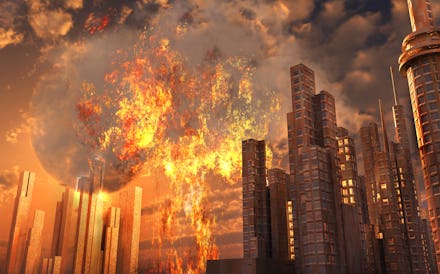This simulator shows just how devastating nuclear war would be for humanity

The fallout of nuclear war is the premise for all sorts of films and video games. There is a sort of morbid curiosity to imagining what life would be like in a post-apocalyptic world caused by this type of warfare, but the threat of such an occurrence is anything but science fiction. To better understand exactly how devastating to the planet and the population that a global nuclear could cause, there's Nuclear War Simulator.
One way to imagine Nuclear War Simulator is like a version of Google Earth with a nuclear option. With a couple clicks, you can find out what the fallout of a conflict between two nuclear superpowers would be, from casualties caused to the long-term effects that follow, including nuclear fallout and radiation levels. The simulator puts you in full control of the experience, allowing you to design your own nuclear forces, establish attack plans and explore potential conflict scenarios and even push to see just how many weapons a nation could produce if they decided to put the full force of their military and economy behind it. Along the way of seeing how these scenarios play out, the Nuclear War Simulator also lets you determine what your chance of survival would be in a nuclear holocaust, based on your location and how the attacks would play out.
It's easy to view tools like Nuclear War Simulator (or others that came before it, like NukeMap) as a sort of game — especially when there are player controls that allow you to build up arsenals, plan attacks and watch the damage roll in — complete with a casualty counter that might feel like a scoreboard if viewed through the wrong lens. Ivan Stepanov, the simulator engineer behind Nuclear War Simulator, doesn't want people to make that mistake when experiencing his simulation. "It is technically not a game as there is no goal and no reward for nuking everybody," he told Vice. Instead, each simulation is intended to be viewed as something to avoid. Stepanov makes a point on his website to include links to the International Campaign to Abolish Nuclear Weapons (ICAN) and International Physicians for the Prevention of Nuclear War (IPPNW) — two organizations that are fully dedicated to mitigating the risk of nuclear conflict arising.
While a simulation presents a useful visualization of just how a nuclear conflict might happen, it's worth recognizing that these types of events aren't purely hypothetical. There are approximately 14,000 nuclear weapons in the world currently, according to Arms Control Association — with about 9,500 of them in active military service (the rest are scheduled to be dismantled). About 90 percent of those weapons are owned by the United States and Russia, which explains why they are often at the center of any fear regarding nuclear war, but there are at least nine countries believed to have active nuclear programs — China, France and the United Kingdom all are considered nuclear states, while India, North Korea and Pakistan all have nuclear weapons and Israel is believed to as well. Many of these are nations that are regularly at odds when it comes to global policies, and while it is unlikely that any would want to escalate a disagreement to the level of nuclear warfare, the possibility of such a thing is an ever-present one for as long as the weapons remain active. The Doomsday Clock, which tracks the likelihood of a man-made global catastrophe, sits at just two minutes to midnight. Let's hope the clock only ever strikes 12 in a simulator.